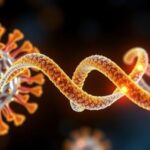When faced with chronic stress, why do some people develop anxiety and depressive symptoms while others show resilience? The results of studies in mice, headed by researchers at Université Laval, indicate that part of the answer could be a cannabinoid receptor that is present in cells in the structure controlling exchanges between the bloodstream and the brain.
“The protein, called cannabinoid receptor type 1 (CB1), is part of the blood-brain barrier, the dynamic structure that protects the brain by regulating the passage of molecules between the bloodstream and the brain,” explained study lead Caroline Ménard, PhD, a professor at Université Laval’s Faculty of Medicine and researcher at the CERVO Brain Research Centre.
“In the context of chronic social stress, the integrity of this barrier is altered, inflammatory molecules make their way into the brain, and anxiety and depressive symptoms appear.” The international team suggests their findings could help researchers identify potential strategies for treating mood disorders.
Ménard and colleagues described their studies in Nature Neuroscience, in a paper titled, “Astrocytic cannabinoid receptor 1 promotes resilience by dampening stress-induced blood-brain barrier alterations.” In their report, the researchers concluded, “Our findings suggest a role for the astrocytic endocannabinoid system in stress response via modulation of the BBB.”
Major depressive disorder (MDD) affects one in five individuals throughout their lifetime, the authors noted, but current treatments have just a 30% success rate, “highlighting the need for a better understanding of underlying causal biological factors.” Chronic stress is the main environmental risk for MDD, the team further pointed out, noting that they had previously reported that both social stress and MDD alter blood-brain barrier (BBB) integrity. “In mice, chronic social stress induces BBB disruption promoting depression-like behaviors, highlighting a link between neurovascular health and stress vulnerability,” they stated. Resilient mice have molecular adaptations that favor BBB integrity, “possibly contributing to coping strategies,” the investigators also noted.
The endocannabinoid system (ECS) is a key regulator of stress responses, and CB1—encoded by the Cnr1 gene—is the main ECS receptor in the brain, the team continued, noting “… CB1 downstream signaling has been implicated in stress resilience.” CB1 receptors are abundant in neurons, but they’re also found in astrocytes, star-shaped cells allowing communication between the brain’s blood vessels and neurons.
“Astrocytes are an essential component of the barrier,” explained Ménard. “We noticed that mice resilient to stress had more CB1 receptors in the barrier than mice with depressive-like behavior or mice not exposed to stress. That gave us the idea to investigate the role of astrocytic CB1 receptors in the response to chronic stress.”
As part of their reported research, the team induced an increase in CB1 receptor abundance in mouse astrocytes in the nuclear acumbens (Nac) structure in the brain, by developing a viral vector that contained the genetic material coding for the CB1 receptor as well as a mechanism that limited its expression only to astrocytes. When injected, this viral construct increased the level of CB1 receptors in the animals’ astrocytes but not in their neurons.
The mice were then subjected to chronic social stress. “Each day, for five minutes, they were brought into direct contact with a dominant male,” Ménard explained. “The rest of the time, a transparent divider was placed in the cage. The mice could see their bully without any physical interaction so it was essentially a psychosocial stress.”
The results showed that three weeks after the injections, levels of CB1 receptors had more than doubled in the astrocytes of mice in the experimental group. “In these mice, baseline anxiety levels—those observed in the absence of stress—were reduced, as were symptoms of anxiety and depression-like behaviors induced by social stress. Overexpression of CB1 receptors leads to resilience by promoting vascular health in the brain,” Ménard continued. “Here we show stress resilience is linked to increases in astrocytic Cnr1 expression in the NAc shell, a subregion controlling reward-seeking behavior,” the authors reported.
Other experiments carried out by her team showed that mice that had access to an exercise wheel or those given antidepressants also had higher levels of CB1 receptors in their astrocytes. “Physical exercise and antidepressant treatment increase the expression of astrocytic Cnr1 in the perivascular region in male mice,” the investigators stated.
In addition, examination of human brains from the Douglas-Bell Canada Brain Bank in Montreal confirmed the association between CB1 receptors and depressive symptoms. “We found that the level of CB1 receptors in astrocytes was lower in people with major depression at the time of death than in people without depression or those treated with antidepressants,” said Ménard. The researchers added in their report, “In human tissue from male donors with major depressive disorder, we observe loss of CNR1 in the NAc astrocytes.”
The combined results suggest the possibility of using molecules capable of activating CB1 receptors in astrocytes to reduce anxiety and depressive symptoms, and to increase resilience in the face of stress, Ménard suggested. “The challenge, however, is to limit their effects to astrocytes, because strong and prolonged activation of the same receptors in neurons can have side effects, notably on alertness, anxiety, and appetite. Until we find a molecule that acts specifically on CB1 receptors in astrocytes, we can mitigate the negative repercussions of stress by taking advantage of the protective effect of physical activity.”
In their paper, the authors further concluded, “To summarize, we propose that perivascular Cnr1 has an important role in modulating stress responses in mice and possibly MDD. Identification of beneficial endocannabinoid-related adaptations within the BBB can represent a promising approach to developing innovative therapies for mood disorders.”



